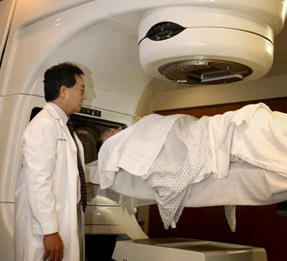Facts About Bladder Cancer
The American Cancer Society estimates that more than 63,000 new cases of bladder cancer will be diagnosed in the United States this year. Seventy-five percent of these will be in men.
In the United States, bladder cancer is the fourth most common cancer in men and eighth most common in women.
The five-year survival rate for all types of bladder cancer is 82 percent. If the cancer is confined to the bladder (non-invasive), the survival rate is 94 percent.
Risk Factors for Bladder Cancer
Bladder cancer is most often found in older white men, but it can be diagnosed in anyone at any age. Other risk factors include:
- Smoking tobacco products.
- Working in jobs where there is possible chemical exposure. For example, dye workers, textile workers, tire and rubber workers, painters, truck drivers, chemical workers, petroleum workers, hairdressers and aluminum workers.
- Chronic bladder inflammation, such as urinary infections, bladder stones and kidney stones.
- Drinking water with high levels of arsenic.
About Bladder Cancer
The bladder is located in the pelvis. It collects and stores urine and has a muscular wall that allows it to contract and expand.
- About 90 percent of bladder cancers are transitional cell carcinoma. Squamous cell carcinoma, adenocarcinoma and small cell carcinoma account for the rest.
- Cancer that is only in the bladder lining is called superficial (non-invasive) bladder cancer. More than 75 percent of bladder cancer is diagnosed as a superficial disease and has an excellent survival rate.
- Invasive bladder cancer penetrates the layers of muscles in the bladder and is more likely to spread to other parts of the body.
Signs and Symptoms of Bladder Cancer
- Blood in urine.
- Painful urination.
- Frequent urination.
- Feeling the need to urinate without being able to.
- Lower back pain.
These symptoms may not be a sign of cancer, but it’s important to have them checked by a doctor.
Diagnosing Bladder Cancer
If you are experiencing signs or symptoms of bladder cancer, your doctor will first examine you and then conduct one or more of the following tests:
- Urinalysis checks the urine for bacteria, blood, protein, sugar and other substances.
- Your doctor may also examine your urine under a microscope to look for cancerous cells. This is called a urine cytology.
- An intravenous pyelogram (IVP) is a test in which a "contrast solution" is put into a vein. X-rays are then taken to see your kidneys, bladder and ureters (the thin tubes that carry urine from the kidneys to the bladder).
- A CT scan of the abdomen and pelvis uses X-rays and a computer to get detailed images of the kidneys, bladder and ureters.
- During a cystoscopy, a thin, telescope-like instrument with a light is inserted gently into the urethra (the tube that carries urine to the outside) and passed into the bladder to examine its lining. The cystoscope also lets your doctor remove a tissue sample to examine it for cancer.
If you are diagnosed with cancer, your doctor may order more tests to see if cancer cells have spread from the bladder to other parts of the body.
Treating Bladder Cancer
Treatment options are based on the type of cancer, your age and your overall health. Bladder cancer, if caught early, can often be cured. The main treatments include:
- Surgery by a surgical oncologist or urologist to remove the cancer or possibly part or all of the bladder.
- Radiation therapy where a radiation oncologist uses high-energy X-rays to destroy the tumor.
- Chemotherapy where a medical oncologist uses drugs to eliminate the cancer. In some instances, drugs may be put directly into the bladder.
- Biologic therapy (also called immunotherapy) where doctors stimulate your immune system to more effectively fight the cancer.
Surgery is often the primary treatment for bladder cancer. To help patients preserve their bladder, doctors in some cases are able to surgically remove part of the bladder and follow up with radiation and chemotherapy. Early results show these treatments to be as effective as complete removal of the bladder and it allows many patients to preserve normal urinary function.
Radiation Therapy Options for Bladder Cancer
Radiation therapy, sometimes called radiotherapy, is the careful use of radiation to safely and effectively treat cancer.
- Radiation therapy works within cancer cells by damaging their ability to multiply. When these cells die, the body naturally eliminates them.
- Healthy cells are also affected by radiation, but they are able to repair themselves in a way cancer cells cannot.
External beam radiation therapy is the main type of radiation used to treat bladder cancer, often in combination with chemotherapy. Internal radiation therapy, or brachytherapy, is also sometimes used.
External Beam Radiation Therapy
External beam radiation therapy involves a series of daily outpatient treatments to accurately deliver radiation to the bladder. These treatments take less than half an hour each, five days a week, for five to seven weeks.
- 3-dimensional conformal radiotherapy (3D-CRT) combines multiple radiation treatment fields to deliver precise doses of radiation to the cancer. This technique helps keep radiation away from nearby healthy tissue.
Potential Side Effects
Patients experience few side effects from radiation therapy and may be able to continue normal routines. Side effects are temporary and usually limited to the area that received radiation.
- Possible problems include skin irritation, nausea, bladder irritation with increased frequency of urination, abdominal cramping, rectal pressure, diarrhea and fatigue.
- Some patients may also suffer from sexual problems, such as vaginal dryness or difficulty achieving an erection.
These side effects may go away over time, but talk to your doctor about any discomfort you feel. He or she may be able to provide drugs and other treatments to help.
To order hard copies copies of this brochure, visit the ASTRO Shop.
